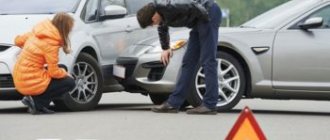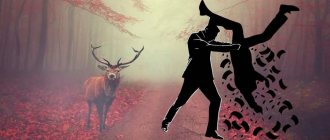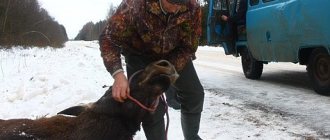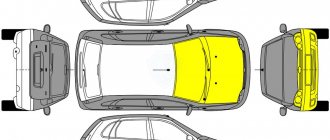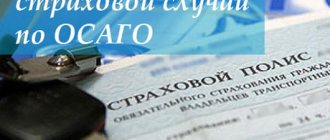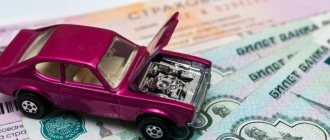The situation regarding road accidents involving animals remains extremely ambiguous. And the ambiguity lies in the fact that animals are not pedestrians, but are considered personal or state property, so the driver is responsible for hitting a moose that suddenly jumped onto the highway.
ATTENTION: An accident involving an animal requires the involvement of our lawyer to reduce the driver’s liability: professionally and on time. Call today!
Is hitting an animal an accident?
It’s worth starting with the fact that animals are divided into domestic (dogs, cats), agricultural (horses, cows, goats, sheep, ducks, chickens) and wild (bears, moose, foxes, hares).
And for each case of an accident with animals, there is its own provision in the traffic rules and the Civil Code of the Russian Federation.
In all cases of injury to an animal or driver on the road, an accident with an animal is considered.
The exception is the case when no one was injured in the accident and the driver managed to brake in time. But even if one of the participants was injured, such a case is considered an accident, but the driver should not be held responsible for all cases.
What to do if you hit an animal on the road?
- If there is a collision with an animal in an accident, then in any case it is worth calling the traffic police, since evasion of recording the accident leads to administrative liability in the form of deprivation of rights for 1.5 years or detention for 15 days.
- If the injured animal has an owner, then according to traffic rules, the driver must compensate for the collision with the animal with money. Our society for the protection of drivers' rights will help you calculate everything correctly and not pay extra.
Animals in traffic rules
In the traffic rules, animals are not considered as separate road users. This is quite logical, because you cannot force a moose to learn the traffic rules and cross the road.
In traffic rules, the concept “animals” appears only a few times:
- In paragraph 1.2 (the concept of “Driver”);
- In section 25, devoted to the movement of horse-drawn carts and the passage of animals;
- In the description of road signs 1.26 “Cattle movement”, 1.27 “Wild animals”, 3.8 “Movement of horse-drawn carts is prohibited”.
These points mainly relate to the passage of farm animals. So if there was a collision with a farm animal, you should turn to section 25 of the traffic rules.
For example, several times I saw how in one of the villages a herd of cows rested right on the roadway. The cows lay down right on the asphalt near a dangerous turn. In the described situation, in the event of an accident, the culprit must be recognized as the animal driver who left the animals unattended.
As for other types of animals, there are no traffic rules for them.
Amount of fines and compensation for an animal killed on the road
If there was a collision with wild animals or, as they are called, hunting resources, then the amount of fines should be looked at in Order of the Ministry of Natural Resources of Russia dated December 8, 2011 No. 948, which approved the methodology for calculating harm. This order contains various formulas for calculating the amount of damage. Taxes have also been approved in order to calculate damage.
For example, the following fees are established:
- for an elk – 80,000 rubles
- per boar – 30,000 rubles
- per duck – 600 rubles
- for a hare – 1,000 rubles
This methodology provides examples of calculating the amount of harm, which allows everyone to understand this methodology. For example, the amount of damage for a sika deer shot down at night during poor visibility will be 60,000 rubles.
In the event of a collision with a pet, the amount of compensation will depend on the amount of damages determined by the owner, since in accordance with Art. 137 of the Civil Code of the Russian Federation, general rules on property apply to animals.
If you are the culprit of an accident
The concept of “animal” in the Civil Code is interpreted unambiguously - it is nothing more than the property of a citizen. When the driver was found guilty of committing an accident, he, in accordance with Part 1 of Art. 1079 of the Civil Code of the Russian Federation, the obligation “to compensate for harm caused by a source of increased danger, unless it can be proven that the harm arose as a result of force majeure or the intent of the victim” applies. That is, the owner of the injured animal can claim compensation for moral damages in court.
Expert advice
Sergey Radko,
Lawyer of the motorists' movement "Freedom of Choice":
— There should be no problems with paying compensation to the owner of the animal. MTPL covers the restoration of property—in this case, an animal. You can tell the owner: “I am insured under MTPL, I am ready to compensate for damage within the designated limit of 400 thousand rubles.”
How to reduce liability for an accident with a wild animal?
You can try to reduce liability for an accident with a wild animal by referring to the following circumstances:
- when driving along the road there were no signs regarding the movement of wild animals
- the vehicle speed corresponded to the permitted speed taking into account road signs
- the collision with the animal occurred at night with poor visibility, and therefore the driver had no real opportunity to prevent an accident with a wild animal
- after a collision with an animal, the driver did not leave the scene of the accident and called the traffic police
- You can also refer to a difficult financial situation or other circumstances to reduce the size of the fine or compensation, which must be documented
You can try to reduce liability, but this is unlikely, since in a situation with wild animals the driver is always to blame, and the amounts of fines and damage calculations are actually fixed, and since the harm was caused to the state, it is difficult to reduce liability, much less avoid it.
HEALTHY:
What does the traffic regulations say?
In the traffic rules, animals are not considered traffic participants, since it is impossible to instill in them the rules of movement on the roadway.
Only a few points mention animals:
- clause 1.2 contains information about them in the driver’s concept;
1. General Provisions
“Driver” is a person driving a vehicle, a driver leading pack animals, riding animals or a herd along the road. A driving instructor is treated like a driver.
- section 25 fully describes the rules for driving animals;
25. Additional requirements for the movement of horse-drawn vehicles,
as well as driving away animals
25.1. Persons at least 14 years of age are allowed to drive a horse-drawn cart (sleigh), or be a driver of pack animals, riding animals or herds when driving on roads.
25.2. Horse-drawn carts (sleighs), riding and pack animals must move only in one row, as far to the right as possible. Driving on the side of the road is allowed if this does not interfere with pedestrians.
Columns of horse-drawn carts (sleighs), riding and pack animals when moving along the roadway must be divided into groups of 10 riding and pack animals and 5 carts (sleighs). To facilitate overtaking, the distance between groups should be 80 - 100 m.
25.3. The driver of a horse-drawn cart (sleigh), when entering the road from an adjacent territory or from a secondary road in places with limited visibility, must lead the animal by the bridle.
25.4. Animals should be driven along the road, usually during daylight hours. Drivers must guide animals as close to the right edge of the road as possible.
25.5. When driving animals across railway tracks, the herd must be divided into groups of such a size that, taking into account the number of drivers, safe passage of each group is ensured.
25.6. Drivers of horse-drawn carts (sleighs), drivers of pack animals, riding animals and livestock are prohibited from:
leaving animals on the road unattended;
drive animals through railway tracks and roads outside specially designated areas, as well as in the dark and in conditions of poor visibility (except for livestock runs at different levels);
lead animals along roads with asphalt and cement concrete pavement if there are other paths.
- information about them is also indicated for some signs, namely 1.26, 1.27 and 3.8.
Thus, the exact concept of hitting a cat or dog is completely absent from the traffic rules.
How to reduce liability for accidents involving livestock?
You can try to reduce the driver’s liability for an accident with a pet by citing the same circumstances as in an accident with a wild animal.
In addition, you can refer to the fact that the owner of the pet improperly kept his pet, and therefore he ended up on the roadway; the fault for the accident that occurred lies with the owner of the pet, and therefore the driver should not be held liable.
If the owner of an animal makes claims for compensation for harm, the cost of the animal, you should check how much the amount of claims he makes corresponds to the real cost of the animal and, if possible, provide evidence that the cost of the animal is lower than that claimed by the owner.
If, as a result of an accident with a pet, if the owner is at fault, the driver’s car is damaged, then it is subject to recovery from the owner. Thus, it is possible to present counterclaims to the owner, which may lead to a partial offset of the amounts.
Attention : watch the video on protecting rights in administrative cases, and also subscribe to our YouTube to learn the advice of a lawyer and receive free advice from a lawyer in Yekaterinburg through comments on the video.
When cattle walk alone
An accident occurred in Zheleznogorsk. In the fall, at 9 pm, a Toyota car hit a dark-colored cow. She suddenly ran out onto the roadway, and the man did not have time to brake. The animal fell on the hood, broke the windshield and died.
The driver called the traffic police, drew up a diagram of the incident, and recorded the location of the collision. There was no "Cattle Driving" sign. Having understood the situation, the inspectors concluded that there were no violations on the part of the car. The cow is to blame for everything, or rather, its owner, who left the cow unattended.
The case was considered by the Krasnoyarsk Regional Court. During the investigation, an examination was ordered, which confirmed that in the evening twilight the driver would not have seen a dark cow on the road. He was moving at a speed of 40 km/h and technically would not have been able to brake if an obstacle suddenly appeared in front of him. The judge concluded that the owner was at fault because she violated the requirements of paragraph 25.6 of the traffic rules - she left the animal unattended and did not take appropriate measures to move it.
On a note! Accidents caused by cows are not uncommon. For example, in 2021, in the Shirinsky district (Republic of Khakassia) there were 15 accidents with livestock, in which 2 people died and two received injuries of varying severity (source: Website of the Russian Ministry of Internal Affairs for the Shirinsky district).
Repairing the damaged car cost the driver 184.5 thousand rubles. The court ordered the owner to reimburse this amount. However, the woman did not agree, because she also lost her wet nurse. And she filed an appeal with a request to reconsider the incident. Perhaps the driver would have had time to stop.
A second hearing was held, but the court, after studying the material, found no grounds for overturning the decision of the first instance, and it entered into legal force.
Photo: the driver of a Lada Granta on Zavodskaya Street in Novotroitsk collided with a cow that was walking unattended along the roadway. Source: orenburg.media
The conclusion to be drawn from this story is that you should not leave your animal without inspection, since it is impossible to predict its behavior. And if it causes damage to someone, then the owner will be responsible.
From the editor! There are situations when cow owners do not show up after an accident and abandon downed animals, fearing that they will be forced to pay for car repairs. But the Burenka is not a stray dog; you can find the owner by interviewing local residents. Experts advise that you must call the traffic police; they are required to include information about the other side of the accident in the protocol.
Apart from an accident, a cow can do anything. There are known cases of bulls attacking people, fences and other expensive objects. The negligent livestock owner will have to pay for the damage from his own pocket. The same applies to goats, rams, geese, roosters, as well as dogs and other pets that can go onto the road and cause an accident there or simply attack others.
Interesting fact! In Sochi, cows and horses often appear on the roads, as their owners let them roam freely. A special service takes stray animals to the “penalty” lot. The owner can return the livestock only by paying a fine of about 10,000 rubles, which is used to reimburse the costs of evacuation and maintenance.
“Specially created commissions conduct daily monitoring of streets and roads both on federal highways and along rural roads.
Experts emphasize that the fight is not against cows and horses, but against the sloppiness of their owners, who must keep the cattle locked up. Walking along the roads, animals pose a threat to life, both for themselves and for drivers.” Sochi Press Service
How to prove an insured event when hitting an animal?
After a collision with an animal has occurred, you should report this to the insurance company, where the driver will be advised how to behave. In addition, if a video recording was made, this recording must be retained as evidence.
- After an accident has occurred, you should call the traffic police, who will record the event.
- In addition to these steps, it is better to take photographs and videos on your phone.
- If necessary, the testimony of witnesses, if any, can be used as evidence.
- With the totality of all the evidence, including traffic police documents, it will not be difficult to prove an insured event when hitting an animal.
How to compensate for damage
If the animal owner is not at fault in the accident, the driver will have to compensate for the damage as the owner of the source of increased danger. The procedure for compensation for damage can take place within the framework of compulsory motor liability insurance, or by filing a claim in court. To obtain insurance, the animal owner must submit an application and documents confirming the amount of damage caused.
The value of pets can be determined by an appraiser, or from documents on their acquisition.
At the federal level, rates for causing damage to wildlife are regulated. For example, for the death of a bear, the driver will have to pay 30,000 rubles.
Such compensation may be forcibly collected from the driver. This procedure looks like this:
- the fact of the death of an animal is recorded by a traffic police officer or another authorized body (for example, a forestry inspector);
- if traffic violations are detected in the driver’s actions, a protocol is drawn up to apply administrative measures;
- on the basis of the protocol and the act of destruction of the animal world, a civil claim is brought against the driver, or an application is submitted to the insurance company.
If a driver is held accountable under the Code of Administrative Offenses of the Russian Federation, the fine imposed for violating traffic rules will be paid not to the owner, but to the state budget. The most serious violations may result in deprivation of rights. For example, if a driver while intoxicated hits an animal, he will be deprived of his license, even if he is not guilty of directly causing damage to the livestock owner.
If the damage to the car was caused by improper control on the part of the animal owner, the driver will be able to compensate for the damage only under a CASCO policy or in the framework of civil proceedings (since the animal owner does not have an MTPL policy). To receive compensation you need to do the following:
- call a traffic police officer to record all the circumstances of the accident, including the nature of the damage to the car;
- contact an appraiser to calculate the cost of restoration repairs;
- submit an application to the insurance company that issued the CASCO policy;
- file a claim in court if the legal owner of the animal is identified.
Problems may arise with determining the owner of the animal or other responsible person.
Payment under the CASCO policy will be made within the amount of insurance coverage. To do this, the insurer will send the car for its own examination, and if you disagree with its conclusions, the driver can contact an independent appraiser. Under the CASCO program, you can receive a referral for repairs or compensation in cash.
When filing a claim in court, you must indicate the owner of the pet or farm animal. If control over the movement of livestock was transferred to other persons (for example, a shepherd), this subject is also included in the defendant’s composition.
When going to court, you need to consider the following nuances:
- the fact of a collision can be confirmed by a report from a traffic police officer, diagrams from the accident scene, photo and video materials;
- if the collision occurred outside the boundaries of the roadway, it will be impossible to receive payment;
- In order to recover damages at the expense of the animal owner, it is necessary to prove what the lack of control was.
If the pet owner is found to be at fault in the form of carelessness or negligence in a lawsuit, the full cost of the damage to the vehicle can be recovered.
Good afternoon to you. Dear Anna, in this case, your right is to enter into an agreement with a lawyer who will protect your rights, or to receive advice. Responsibilities are to pay for all damage incurred.
Do you have any additional questions?
You can click the link next to the avatar (Last name, first name).
Feedback and gratitude are welcome, but not required.
Good afternoon, dear reader.
This article will focus on hitting an animal with a car . You will learn whether hitting an animal is a traffic accident, as well as the liability that the driver faces for hitting an animal.
Every year in Russia thousands of animals end up under wheels. In large populated areas, it is mainly domestic animals (dogs and cats) that are run over. In rural areas, farm animals (chickens, ducks, sheep, goats, cows and horses) become victims of cars. On country roads, wild animals (hares, foxes, roe deer, moose, bears and others) get under the wheels.

